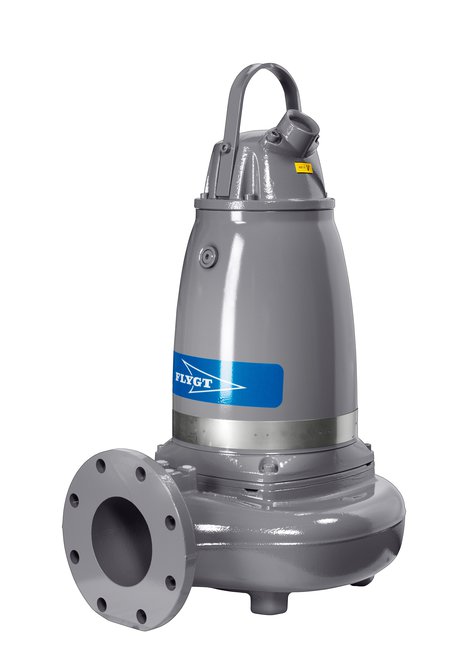Pump provides sustained operating efficiencies

The key operating requirement for any sewage handling pump is its ability to pass solids without clogging, ie, either a full or a partial clog of the impeller and/or volute. A full clog exists when the pump has ceased to pump. This condition is easy to detect and highly undesirable - an immediate service call is needed to remove the pump and manually clean out the clog.
A partially clogged pump, however, is harder to detect because the pump delivers flow at a varying reduced rate. This can go unnoticed for long periods of time, resulting in a number of adverse operating conditions. These include increased energy usage, reduced Q/H performance, longer run times and vibration. If the pump is operated continuously, the pump efficiency will gradually decline to levels as low as half of the clean water efficiency or lower. A pump operating for extended periods of time at substantially reduced overall efficiencies results in much higher consumed power and running costs.
Impeller design is fundamental to how well sewage pumps can operate without clogging. Traditionally, it was assumed impellers with large throughlets would eliminate clogging. Throughlet size is determined by the largest diameter of a hard, solid, spherical object that can pass through the pump. The concept is old, dating back to 1915, and was developed at a time when energy costs were not of significant importance.
Pump manufacturers and operators intuitively believed that pump clogging could be avoided simply by having an internal pump throughlet equal to or larger than what the toilet of the day could pass. The last few decades of research and development, coupled with experience from hundreds of thousands of pump installations, have proven that this simplistic logic of throughlet size is incorrect and misleading. It has been found that the vast majority of full and partial pump clogging occurs from long fibrous material such as rags accumulating on the leading edge of the pump’s impeller and/or between the rotating and stationary wear rings. Yet the practice of specifying a minimum throughlet size for wastewater pumps within requests for tender specifications is still prevalent today.
The Flygt N-pump, from Xylem, utilises a completely different hydraulic design to that of traditional sewage handling pumps, such as the closed channel and vortex impeller designs. The pump has been designed with a semi-open impeller with backswept leading edges working together with a relief groove located in the lower section of the pump volute. The design allows the impeller and hydraulic areas to clear itself of any build-up of rag or fibrous materials. This self-cleaning function ensures the hydraulic profile of the impeller is maintained, resulting in the pump being able to operate with sustained high operating efficiencies.
“This fundamental design change to a self-cleansing impeller was adopted quickly by our customers,” said Terry Gralton, Xylem Oceania’s wastewater manager. “Operators found they experienced fewer pump chokes and reduced electrical power costs when using the N-pump.”
In recent years, options have been further developed to provide operators the ability to customise the Flygt N-pump to suit their on-site conditions. Impeller material options include hard iron and duplex stainless steel materials, providing increased service life when high corrosion and erosion conditions are present.
In addition to material options, the pump can also be equipped with new impeller designs to better handle sewage with abnormally high concentrations of rag and solid materials. The Adaptive N-impeller provides the ability for the impeller to move axially when needed, allowing bulky rags and debris to pass through the pump. Also available is the option of a chopper impeller to reduce clogging in heavily ragged sewage pumping stations. High-efficiency IE3 drive motors are available when required to minimise the drive motor’s consumed electrical power.
A first line of defence in wastewater screening
Two Queensland councils have opted for Australian-manufactured screening technology to protect...
Beef processor selects wastewater pump solution for dual purpose
John Dee Warwick wanted to upgrade its wastewater pump system to handle the day-to-day flows...
Melbourne Water finds an energy-saving solution
Sewage and wastewater treatment is a highly energy-intensive process, presenting a challenge for...







